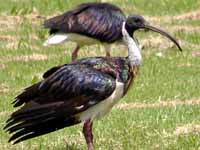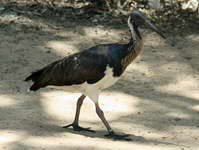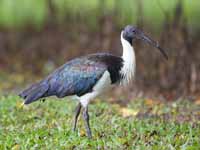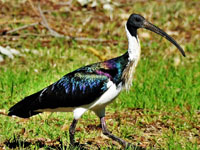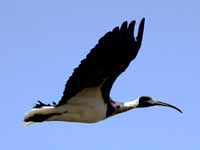THE WORLD BIRDS - An Online Bird Book
Order Pelicaniformes
The Pelicaniformes currently contain the pelicans (Pelecanidae), herons (Ardeidae), spoonbills and ibises (Threskiornithidae), Hammerkop (Scopidae), and shoebill (Balaenicipitidae). This order may need to be separated into additional orders as the similarities of these families may be due to convergent evolution and not common ancestors.
Threskiornithidae Family - Ibis and Spoonbills
Order Pelicaniformes
The Pelicaniformes currently contain the pelicans (Pelecanidae), herons (Ardeidae), spoonbills and ibises (Threskiornithidae), Hammerkop (Scopidae), and shoebill (Balaenicipitidae). This order may need to be separated into additional orders as the similarities of these families may be due to convergent evolution and not common ancestors.
Threskiornithidae Family - Ibis and Spoonbills
The sexes are similar in appearance, but males average larger than females. They are large birds, but mid-sized by the standards of their order. The smallest of the family, the dwarf olive ibis, is 45 cm (18 in) long and weighs 450 g (0.99 lb),. The largest, the giant ibis, 100 cm (39 in) long and weights 4.2 kg (9.3 lb) .
They feed on of invertebrates and small vertebrates. Ibises hunt by probing in soft earth or mud, spoonbills by swinging the bill from side to side in shallow water. Ibises have sensory pits around the tips of their bills, enabling them to locate insects and earthworms. At night, they roost in trees near water. They are gregarious, feeding, roosting, and flying together, often in formation.
Most ibises are colonial nesters, while spoonbills nest singularly or in small groups. The nests are created out of reeds and sticks and located in trees. The male brings the material to the female which builds the nest. Both sexes take part in incubating the eggs and later feeding the chicks.
Taxonomy
In the 1990s, the ibis and spoonbill family was considered to belong to the same order as the storks, Ciconiiformes. DNA evidence currently implies that Threskiornithida should beloing to the same order as the pelicans. There are 13 ibis genera and only one spoonbill genus.
Etymology
The name Threskiornithidae comes from the greek for “sacred bird”. In fact, the ibis species Threskiornis aethiopicus is called the sacred ibis. That name goes back to ancient Egyptian religions, so Egypt also has a claim for the root of the family name
Genus Bostrychia
Ibis,_Hadada Bostrychia hagedash
Description: Grey to partly brown plumage; white cheek, neck, breast; blackish legs; grey to black bill.
Range: Sub-Saharan Africa.
Habitat and Behavior: Found grasslands, wetlands; also urban parks, fields, gardens. Needs moist and soft soil for probing. Roosts colonially at night. Eats insects, millipedes, earthworms; also snails, spiders, small lizards. Tolerates people; common in many African cities.
Subspecies:
B. h. brevirostris – Senegal to Kenya and south to Zambezi River Valley
B. h. hagedash – Southern Africa (south of the Zambezi Valley)
B. h. nilotica – Sudan and Ethiopia to DR Congo, Uganda and nw Tanzania
Status: Least concern.
.
Similar to: Wattled Ibis. Hadada has white cheek; Wattled Ibis has brown head.
Similar to: Whte Ibis. Juveniles of these species are similar. If found in USA, then White Ibis.
Image by: 1) Cristiano Crolle - South Africa 2, 3,Dick Daniels - South Africa 4) Dick - Tanzania
5) Dick - National Aviary 6) Dick - KenyaRange: Sub-Saharan Africa.
Habitat and Behavior: Found grasslands, wetlands; also urban parks, fields, gardens. Needs moist and soft soil for probing. Roosts colonially at night. Eats insects, millipedes, earthworms; also snails, spiders, small lizards. Tolerates people; common in many African cities.
Subspecies:
B. h. brevirostris – Senegal to Kenya and south to Zambezi River Valley
B. h. hagedash – Southern Africa (south of the Zambezi Valley)
B. h. nilotica – Sudan and Ethiopia to DR Congo, Uganda and nw Tanzania
Status: Least concern.
.
Similar to: Wattled Ibis. Hadada has white cheek; Wattled Ibis has brown head.
Similar to: Whte Ibis. Juveniles of these species are similar. If found in USA, then White Ibis.
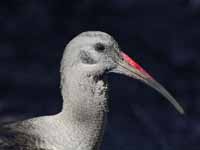
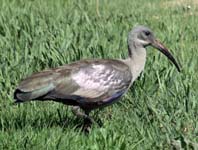

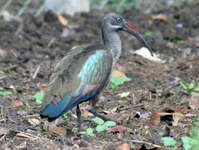
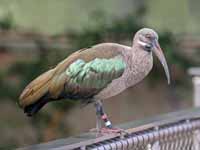

Ibis,_Olive Bostrychia olivacea
Description: Relatively small ibis. Greenish bronze back; dusky rump; dark blue tail; pinkish green tinged wing coverts.
Range: Central Africa.
Habitat and Behavior: Found in dense forests, regenerating forests, marshes, swamps. Eats beetles, grubs, snails. Roosts in trees at night. Nest composed of dead branches on tree branch looking surprisingly unstable for a bird of its size.
Subspecies:
B. o. akeleyorum – Kenya, Tanzania
B. o. cupreipennis – Cameroon, Gabon, Congo, DR Congo
B. o. olivacea – Sierra Leone, Liberia
Status: Least concern.
Image by:
1) Merrittimages 2) Michal Porebiak - EthiopiaRange: Central Africa.
Habitat and Behavior: Found in dense forests, regenerating forests, marshes, swamps. Eats beetles, grubs, snails. Roosts in trees at night. Nest composed of dead branches on tree branch looking surprisingly unstable for a bird of its size.
Subspecies:
B. o. akeleyorum – Kenya, Tanzania
B. o. cupreipennis – Cameroon, Gabon, Congo, DR Congo
B. o. olivacea – Sierra Leone, Liberia
Status: Least concern.
1) Juvenile
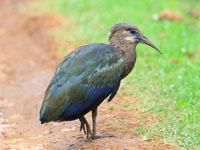
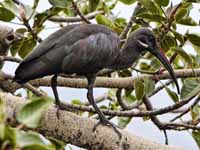
Ibis,_Sao_Tome Bostrychia bocagei
Description: Slightly bronzed mantle, wing-coverts; dull olive head; blackish around eyes.
Range: São Tomé Isand off the western coast of Central Africa.
Habitat and Behavior: Prefers forest below 450 meters. Forages for food on forest floor with sparse undergrowth. Silent most of time, but disturbed it gives various coughed grunts; harsh honking when going to roost.
Status: Critically endangered.
Image by: 1, 2) Nik_BorrowRange: São Tomé Isand off the western coast of Central Africa.
Habitat and Behavior: Prefers forest below 450 meters. Forages for food on forest floor with sparse undergrowth. Silent most of time, but disturbed it gives various coughed grunts; harsh honking when going to roost.
Status: Critically endangered.
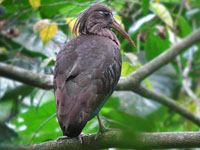
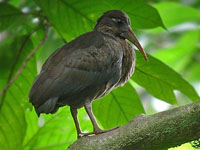
Ibis,_Spot-breasted Bostrychia rara
Description: Mainly dark upperparts; buff spotted neck, breast; red bill; blue-black wings; black underwing.
Range: Central Africa.
Habitat and Behavior: Found wooded swamps or forested areas near streams. Usually silent; loud call flying to and from roost Does not migrate. Rarely seen.
Status: Least concern.
Image by: 1) KaniRange: Central Africa.
Habitat and Behavior: Found wooded swamps or forested areas near streams. Usually silent; loud call flying to and from roost Does not migrate. Rarely seen.
Status: Least concern.

Ibis,_Wattled Bostrychia carunculata
Description: mainly brown plumage; white shoulder patches; thin wattle attached to base of bill; no white cheek; dusky red bill; red eye. Length is about 65–75 cm.
Range: Ethiopia and Eritrea.
Habitat and Behavior: Prefers meadows and highland river courses; also cultivated land, city parks. Walks methodologically, probing ground for food. Feeds on worms, insect larvae, small invertebrates; occasionally frogs, snakes, mice. Roosts in trees, rock cliffs. Predominantly terrestrial; short flights to change altitude. Nest is platform of branches, sticks; lined with grass, bark.
Status: Least concern.
.
Similar to: Hadada Ibis. Hadada has white cheek; Wattled Ibis has brown head.
Image by: 1, 2) Colleen Taugher 3) Veli
4) Nik_Borrow - EthiopiaRange: Ethiopia and Eritrea.
Habitat and Behavior: Prefers meadows and highland river courses; also cultivated land, city parks. Walks methodologically, probing ground for food. Feeds on worms, insect larvae, small invertebrates; occasionally frogs, snakes, mice. Roosts in trees, rock cliffs. Predominantly terrestrial; short flights to change altitude. Nest is platform of branches, sticks; lined with grass, bark.
Status: Least concern.
.
Similar to: Hadada Ibis. Hadada has white cheek; Wattled Ibis has brown head.
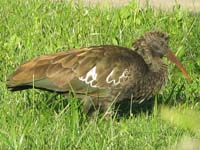



Genus Cercibis - 1 species
Ibis,_Sharp-tailed Cercibis oxycerca
Description: Glossy black plumage; longest tail of the ibises; orange-red bill, legs, feet, facial skin. Males larger than females
Range: northern South America.
Habitat and Behavior: Inhabits wet lowland savannas, riverbanks ; less than 300-500m above sea level. Forages mainly in moist soil, shallow mud; also shallow water. Eats insects, amphibians, crustaceans, earthworms, snails. Noisy wing beating; slow labored flight, only covering short distances. Particularly vocal fon an ibis.
Status: Least concern.
Image by: 1) Miguel Jacques 2) Barloventomagico - Venezuela 3) Cornell_Univ's_Neotropical_Birds_Online - Carlos_Siegert in VenezuelaRange: northern South America.
Habitat and Behavior: Inhabits wet lowland savannas, riverbanks ; less than 300-500m above sea level. Forages mainly in moist soil, shallow mud; also shallow water. Eats insects, amphibians, crustaceans, earthworms, snails. Noisy wing beating; slow labored flight, only covering short distances. Particularly vocal fon an ibis.
Status: Least concern.
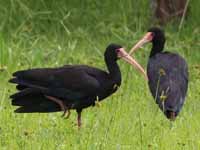
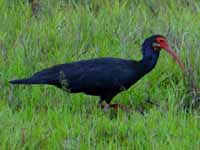
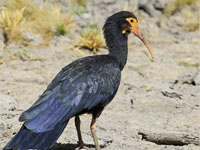
Genus Eudocimus
These ibis forage by probing with their long, down-curved beaks. Eats fish, frogs, crustaceans and insects. Flies with neck and legs outstretched, often in long, loose lines, especially on their way to or from the night-time roosts.
Ibis,_Scarlet Eudocimus ruber
Description: Bright scarlet plumage; black wingtips; red bill, feet.
Range: Caribbean, northern South America.
Habitat and Behavior: Found in marshy habitats, including mud flats, shoreline, rainforest. Colonial breeding.
Status: Least concern.
Image by: 1) Casliber 2) Dick - Birds of Eden 4, 5) Dick Daniels - Sylvan Heights 3, 6) Sandy Cole - Birds of Eden, South Africa 7) Gabriel_CaparóRange: Caribbean, northern South America.
Habitat and Behavior: Found in marshy habitats, including mud flats, shoreline, rainforest. Colonial breeding.
Status: Least concern.
1) Range (orange) 2, 3) Juvenile

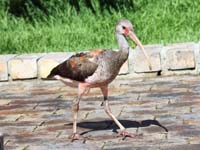
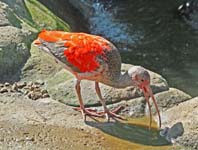
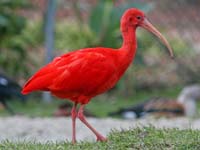
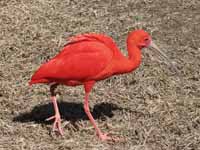

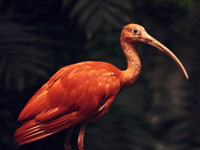
Ibis,_White also American White Ibis Eudocimus albus
Description: Mainly white plumage; black-tipped wings, pink facial skin. Males larger than females. Male average weight 1,036 g (2.28 lb), female 764 g (1.68 lb).
Range: southern US, Central America, northern South America.
Habitat and Behavior: Eats small aquatic prey; probes with bill in shallow water for prey. Large colonies in breeding season.
Status: Least concern.
Similar to: Australian White Ibis, Black-headed Ibis. Range does not overlap.
Similar to: Limpkin. Juvenile White Ibis has white belly; Limpkin has dark belly.
Image by: 1) Casliber 2, 3, 6, 7)
Dick Daniels in North Carolina 5, 8, 9) Dick - Florida 4) Alan D. Wilson - South Padre Island,
TexasRange: southern US, Central America, northern South America.
Habitat and Behavior: Eats small aquatic prey; probes with bill in shallow water for prey. Large colonies in breeding season.
Status: Least concern.
Similar to: Australian White Ibis, Black-headed Ibis. Range does not overlap.
Similar to: Limpkin. Juvenile White Ibis has white belly; Limpkin has dark belly.
1) Range (blue) 2, 3, 4) Juvenile


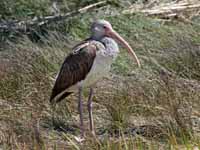
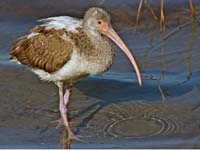

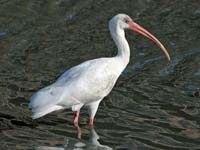
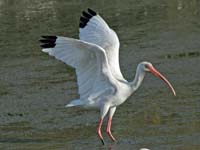
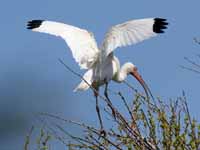

Genus Geronticus
The bald ibis have blad heads which gives them a vulture like appearance. They also differ from other ibis by breeding on cliffs rather than trees and preferring arid locations to wetlands. Geronticus is derived from the Greek work for “old man”, which refers to the bald head of the species.
Ibis,_Northen Bald also Waldrapp Geronticus eremita
Description: Glossy blackish plumage; bare reddish head; red bill, legs.
Range: northern Africa (mainly Morocco).
Habitat and Behavior: Found cliff ledges. Hunts food in dry, grazed areas such as semi-arid steppes and fallow fields. Eats lizards, beetles, snails other invertebrates.
Status: Endangered.
Image by: 1, 2) Agustin Povedano - Spain 3) Dezidor 4) Cristiano Crolle - Northern Italy Range: northern Africa (mainly Morocco).
Habitat and Behavior: Found cliff ledges. Hunts food in dry, grazed areas such as semi-arid steppes and fallow fields. Eats lizards, beetles, snails other invertebrates.
Status: Endangered.
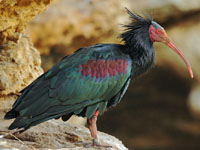
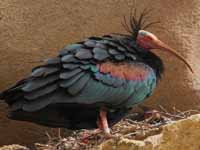
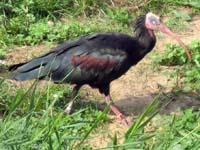
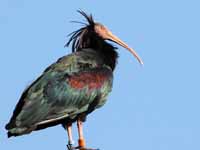
Ibis,_Southern Bald Geronticus calvus
Description: Glossy blackish plumage; bare head with red crown, pale face.
Range: southern Africa.
Habitat and Behavior: Prefers arid habitats in highlands. Breeds on cliffs. Feeds and roosts in large groups. Eats insects and other small invertebrates. Not vocal.
Status: Vulnerable.
Image by: 1) Sarefo - Cologne Zoo,
Germany 2, 3) Dick Daniels - Tampa's Lowry Park Zoo 4, 5) Dick - San Diego Zoo 6) Sandy Cole - San Diego ZooRange: southern Africa.
Habitat and Behavior: Prefers arid habitats in highlands. Breeds on cliffs. Feeds and roosts in large groups. Eats insects and other small invertebrates. Not vocal.
Status: Vulnerable.
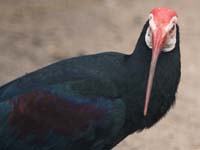
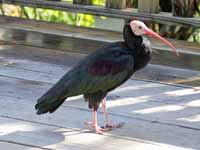
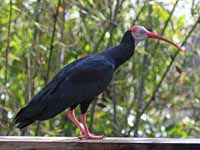
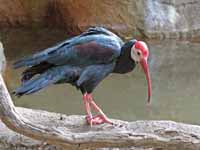

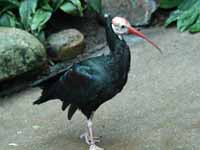
Genus Lophotibis- 1 species
Ibis,_Madagascar Lophotibis cristata Found:
Description: Mostly brown plumage; glossy greenish-blue head; red orbital skin; red legs; yellow bill; white wings.
Range: Madagascar.
Habitat and Behavior: Occurs in woodlands and forests. Eats mainly insects, spiders, frogs, reptiles, snails, invertebrates.
Subspecies:
L, c. cristata – e Madagascar
L. c. urschi – w Madagascar
Status: Near threatened.
Image by: 1) Eric Savage at the Bronx Zoo, USA 2) Joe
- Bronx Zoo 3, 4) Dick Daniels - San Diego Zoo Range: Madagascar.
Habitat and Behavior: Occurs in woodlands and forests. Eats mainly insects, spiders, frogs, reptiles, snails, invertebrates.
Subspecies:
L, c. cristata – e Madagascar
L. c. urschi – w Madagascar
Status: Near threatened.
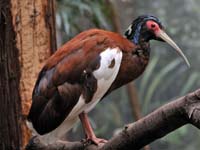
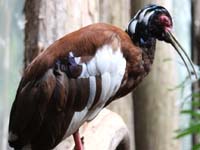
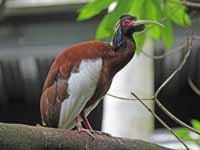

Genus Mesembrinibis - 1 species
Ibis,_Green Mesembrinibis cayennensis
Description: Mainly green plumage; pale green bill, legs; grey bare facial skin.
Range: Costa Rica south to northern Argentina and Paraguay.
Habitat and Behavior: Frequents forested wetland habitats, such as swamps , river edges. Usually solitary or in pairs. Roosts in trees. Eats fish, insects, frogs and other aquatic prey
Status: Least concern.
Image by: 1) Dario Sanches -
Brazil 2) Claudio Timm 3) Blake Matheson 4) Alastair RaeRange: Costa Rica south to northern Argentina and Paraguay.
Habitat and Behavior: Frequents forested wetland habitats, such as swamps , river edges. Usually solitary or in pairs. Roosts in trees. Eats fish, insects, frogs and other aquatic prey
Status: Least concern.

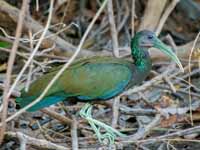
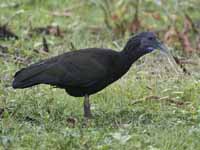
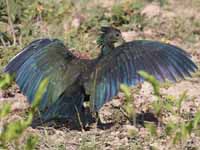
Genus Nipponia
Ibis,_Crested Nipponia nippon
Description: White plumage; substantial red bare skin on head; dense crest of white plumes on nape.
Range: Only natural (non-reintroduced) population in Shaanxi, China. Extensive captive breeding programs in Japan, China.
Habitat and Behavior: Mainly eats frogs, small fish, small animals. Builds nest in hillside trees.
Status: Endangered.
Image by: 1) Hisagi 2) Ken 3) DanielinblueRange: Only natural (non-reintroduced) population in Shaanxi, China. Extensive captive breeding programs in Japan, China.
Habitat and Behavior: Mainly eats frogs, small fish, small animals. Builds nest in hillside trees.
Status: Endangered.

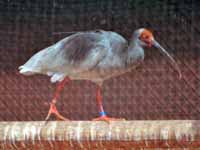

Genus Phimosus - 1 species
Ibis,_Bare-faced Phimosus infuscatus
Description: Dark brown or blackish plumage; reddish bare face; pale bill; pink legs.
Range: South America.
Habitat and Behavior: Occurs in wet meadows, savannas, marshes, rice fields. Forages in moist soil, edges of standing water. Eats insects, worms, clams, other small invertebrates. Usually near sea level.
Subspecies:
P. i. berlepschi – Colombia to the Guianas, Suriname, nw Brazil
P. i. infuscatus – Bolivia to Paraguay, Argentina, Uruguay
P. i. nudifrons – Brazil south of the Amazon
Status: Least concern.
Image by: 1, 2) Cláudio Timm in Rio Grande do Sul, Brazil 3) Gustavo Duran 4) Barloventomagico - VenezuelaRange: South America.
Habitat and Behavior: Occurs in wet meadows, savannas, marshes, rice fields. Forages in moist soil, edges of standing water. Eats insects, worms, clams, other small invertebrates. Usually near sea level.
Subspecies:
P. i. berlepschi – Colombia to the Guianas, Suriname, nw Brazil
P. i. infuscatus – Bolivia to Paraguay, Argentina, Uruguay
P. i. nudifrons – Brazil south of the Amazon
Status: Least concern.
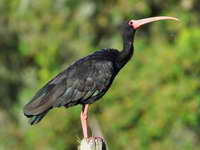
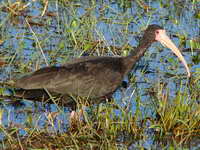
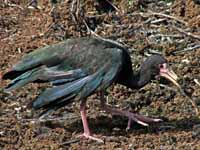
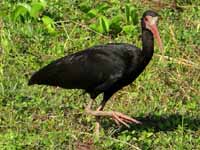
Genus Platalea
Spoonbill, African Platalea alba
Description: Mainly white plumage; red face, legs; grey bill. Juveniles lack the red face and have a yellow bill.
Range: Africa and Madagascar, including Botswana, Kenya, Mozambique, Namibia, South Africa, Zimbabwe.
Habitat and Behavior: Lives near shallow aquatic areas. Swings its open bill side-to-side in water to catch prey. Colonial nester in trees or reedbeds. Nest built from sticks and reeds and lined with leaves; generally located in trees above water.
Status: Least concern.
Image by: 1) Dick Daniels - St. Lucia, South Africa 2) Dick - San Diego Zoo
3) Dick - Birds of Eden, South Africa 4) Charlie Westerinen - Zimbabwe 5) Nik_Borrow - UgandaRange: Africa and Madagascar, including Botswana, Kenya, Mozambique, Namibia, South Africa, Zimbabwe.
Habitat and Behavior: Lives near shallow aquatic areas. Swings its open bill side-to-side in water to catch prey. Colonial nester in trees or reedbeds. Nest built from sticks and reeds and lined with leaves; generally located in trees above water.
Status: Least concern.



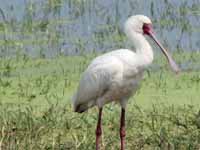
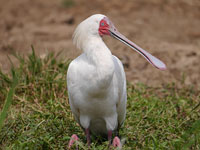
Spoonbill, Black-faced Platalea minor
Description: Mainly white plumage; black surrounds eyes and forehead; black bill; dark legs. Breeding: yellow breast-patch; white crest.
Range: Coastal areas of eastern Asia.
Habitat and Behavior: Mud Flats, coastal shores, sea cliffs.
Status: Endangered due to destruction loss; also humans disturbing nests.
Similar to: Eurasian Spoonbill. Breeding Eurasian Spoonbill has yellow-tipped black bill; breeding Black-faced Spoonbill has black bill with no yellow tip. Black-faced Spoonbill has black face.
Image by: 1) Charles Lam 2) Darren Bellerby - Hong Kong Wetland Park, Hong Kong 3) Cp9asngfRange: Coastal areas of eastern Asia.
Habitat and Behavior: Mud Flats, coastal shores, sea cliffs.
Status: Endangered due to destruction loss; also humans disturbing nests.
Similar to: Eurasian Spoonbill. Breeding Eurasian Spoonbill has yellow-tipped black bill; breeding Black-faced Spoonbill has black bill with no yellow tip. Black-faced Spoonbill has black face.
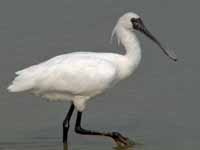
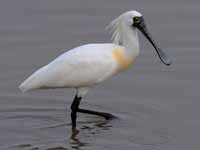
Spoonbill, Eurasian also Common Spoonbill Platalea leucorodia
Description: Mainly white plumage; yellow breast-patch; black bill with yellow tip; dark legs, crest. Nonbreeding: lacks crest, breast-patch. Juvenile: pale bill; black tipped primary feathers.
Range: Eurasia, Africa.
Habitat and Behavior: Found near marsh, river, lake, flooded areas, mangrove swamp. Eats small fish, insects, crustaceans, tappolls and more. Depending on local, colonial nests can be in trees, shrubs, ground.
Subspecies:
P. l. archeri – Coasts of Red Sea and Somalia
P. l. balsaci balsaci – Banc d’Arguin (off coast of Mauritania)
P. l. leucorodia – S Palearctic to India; winters to central Africa and se China
Similar to: Black-faced Spoonbill. Breeding Eurasian Spoonbill has yellow-tipped black bill; breeding Black-faced Spoonbill has black bill with no yellow tip. Black-faced Spoonbill has black face.
Image by: 1) Creando 2) Bhardwaj Shanthanu - India 3) Iacopo
lea - Italy 4) Andreas Trepte 5) Cristiano Crolle - Texel, Holland Range: Eurasia, Africa.
Habitat and Behavior: Found near marsh, river, lake, flooded areas, mangrove swamp. Eats small fish, insects, crustaceans, tappolls and more. Depending on local, colonial nests can be in trees, shrubs, ground.
Subspecies:
P. l. archeri – Coasts of Red Sea and Somalia
P. l. balsaci balsaci – Banc d’Arguin (off coast of Mauritania)
P. l. leucorodia – S Palearctic to India; winters to central Africa and se China
Similar to: Black-faced Spoonbill. Breeding Eurasian Spoonbill has yellow-tipped black bill; breeding Black-faced Spoonbill has black bill with no yellow tip. Black-faced Spoonbill has black face.
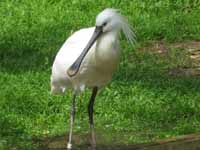
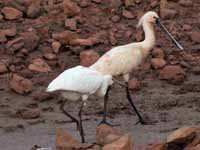
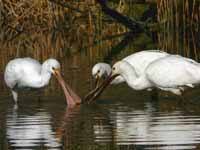
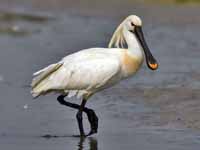

Spoonbill, Roseate Platalea ajaja also Ajaia ajaja Found
Description: Pink plumage varies in color depending on diet and age; flat grey bill. Length 71–86 cm (28–34 in), wingspan 120–133 cm (47–52 in), weight 1.2–1.8 kg (2.6–4.0 lb).
Range: Florida, Central and South America, Caribbean.
Habitat and Behavior: Found shallow fresh or coastal waters. Eats crustaceans, aquatic insects, frogs, newts. Flat bill lets eat smaller fish than ibis.
Status: Least concern.
Image by: 1, 3) Dick Daniels - Ding Darling National Wildlife Refuge, Sanibel Island, Florida
2) Sandy Cole - Flamingo
Gardens, Flroida 4) Sandy Cole - Sylvan Heights 5) Dick - San Francisco Zoo 6) Dick - San Diego Zoo 7) Dick - National Aviary 8) Dominic SheronyRange: Florida, Central and South America, Caribbean.
Habitat and Behavior: Found shallow fresh or coastal waters. Eats crustaceans, aquatic insects, frogs, newts. Flat bill lets eat smaller fish than ibis.
Status: Least concern.

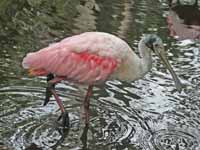

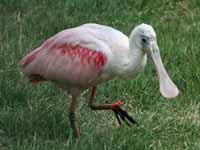
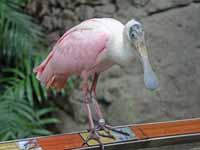

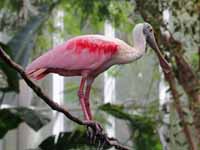
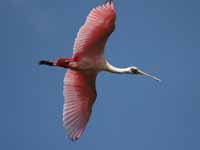
Spoonbill, Royal also Black-billed Spoonbill Platalea regia
Description: white plumage; black bill, legs; red patch over eyes.
Range: Australia, New Zealand, Indonesia, Papua New Guinea, the Solomon Islands.
Habitat and Behavior: Lives in wetlands. Eats crustaceans, fish and small insects by sweeping its bill from side to side.
Status: Least concern.
Image by: 1, 3, 4) Dick Daniels - Australia 2) Dick - Australia Range: Australia, New Zealand, Indonesia, Papua New Guinea, the Solomon Islands.
Habitat and Behavior: Lives in wetlands. Eats crustaceans, fish and small insects by sweeping its bill from side to side.
Status: Least concern.
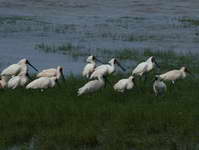
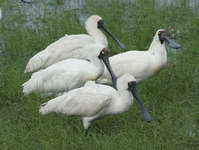
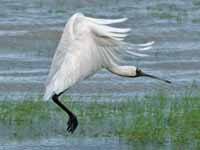
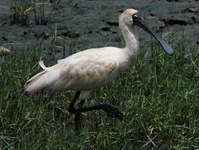
Spoonbill, Yellow-billed Platalea flavipes
Description: White plumage; yellowish bill, legs, feet; featherless face.
Range: native to Australia, vagrant to New Zealand.
Habitat and Behavior: Prefers edges of lakes and swamps, also flooded areas. Eats, fish, snails, insects. Walks slowly, kicking up debris and small animals, which it senses then catches with its bill. Colonial nester in trees or reedbeds.
Status: Least concern.
Image by: 1) Petr Baum - Zoo in Healesville, Victoria 2, 3) Sandy
Cole - San Diego Zoo 4) patrick kavanaghRange: native to Australia, vagrant to New Zealand.
Habitat and Behavior: Prefers edges of lakes and swamps, also flooded areas. Eats, fish, snails, insects. Walks slowly, kicking up debris and small animals, which it senses then catches with its bill. Colonial nester in trees or reedbeds.
Status: Least concern.
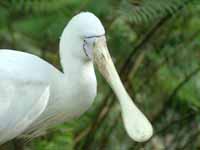
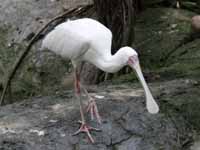

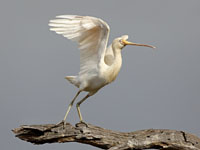
Genus Plegadis
The Plegadis genus is probably most closely related to the Eudocimus genus. Eudocimus is the older lineage.
Ibis,_Glossy Plegadis falcinellus Found
Description: Breeding: glossy reddish-brown plumage; green wings; brownish billl; dark facial skin; red-brown legs. Nonbreeding and juveniles: duller.
Range: All continents except Antarctica.
Habitat and Behavior: Mainly found in shallow freshwater areas; also shallow coastal areas. Feeds on available food supply: insects, crustaceans, fish, etc. Nest made from twigs and vegetation; located in trees or shrubs. Both sexes incubate the eggs.
Status: Least concern.
Similar to: Limpkin. Glossy Ibis is darker and its bill is more curved than Limpkin.
Similar to: White-faced Ibis. Adult Glossy Ibis has dark eyes; adult Glossy Ibis has red eyes. Nonbreeding Glossy Ibis and White-faced Ibis are very similar. Breeding White-faced Ibis has a white border around its face.
Image by: 1, 2) Dick Daniels- Flamingo Gardens, Florida 3) Sylvan de Munck 4) Mehmet Karatay 5) Agustin_Povedano 6) ) Dick - Venice, Florida 7) Alan D. Wilson - CaliforniaRange: All continents except Antarctica.
Habitat and Behavior: Mainly found in shallow freshwater areas; also shallow coastal areas. Feeds on available food supply: insects, crustaceans, fish, etc. Nest made from twigs and vegetation; located in trees or shrubs. Both sexes incubate the eggs.
Status: Least concern.
Similar to: Limpkin. Glossy Ibis is darker and its bill is more curved than Limpkin.
Similar to: White-faced Ibis. Adult Glossy Ibis has dark eyes; adult Glossy Ibis has red eyes. Nonbreeding Glossy Ibis and White-faced Ibis are very similar. Breeding White-faced Ibis has a white border around its face.
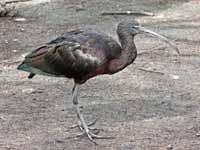
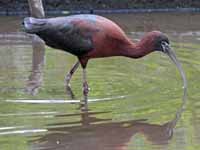
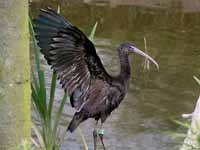
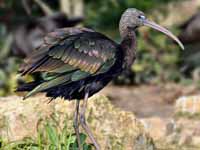
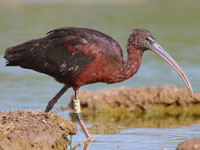
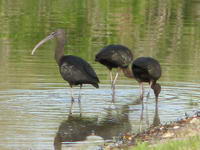
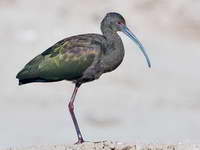
Ibis,_Puna Plegadis ridgwayi Found: Argentina, Bolivia, Chile, Peru
Description: Mainly dark chestnut plumage; fine white steaks head, neck; pale pink bill.
Range: Argentina, Bolivia, Chile, Peru.
Habitat and Behavior: Its natural habitats are swamps, marshes lakes; mostly in high land. Occasionally at sea level.
Status: Least concern.
Image by: 1) Thomas Quine 2) Francesco_Veronesi Dick Daniels - Urubamba, Peru 3) Dick - Andes of PeruRange: Argentina, Bolivia, Chile, Peru.
Habitat and Behavior: Its natural habitats are swamps, marshes lakes; mostly in high land. Occasionally at sea level.
Status: Least concern.
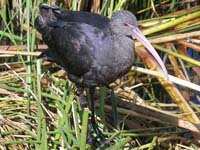
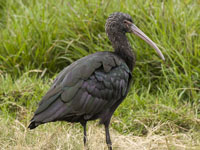


Ibis,_White-faced Plegadis chihi
Description: Breeding: pink bare face bordered by white feathers; grey bill; red legs; eyes. Nonbreeding: no white face. Length 44 – 56 cm (18 – 22 in), weight 450 – 525 g (16 – 18.5 oz, wingspan 90 -93 cm (35 – 36 in).
Range: west USA to South America.
Habitat and Behavior: Prefers swamps, bogs, marshes. Eats fish, frogs, many invertebrates. Colonial nester in stubs and low trees. Uses reeds for nest. Blue-green eggs
Status: Least concern.
Similar to: Glossy Ibis. Adult Glossy Ibis has dark eyes; adult Glossy Ibis has red eyes. Nonbreeding Glossy Ibis and White-faced Ibis are very similar. Breeding White-faced Ibis has a white border around its face.
Image by: 1, 4, 5 Cláudio Timm - Brazil 2) Dan Pancamo - Texas 3) Kevin Cole along the Pacific Coast, USA
6) Alan D. Wilson - near Burns, Oregon 7) nebirdsplus - MassachusettsRange: west USA to South America.
Habitat and Behavior: Prefers swamps, bogs, marshes. Eats fish, frogs, many invertebrates. Colonial nester in stubs and low trees. Uses reeds for nest. Blue-green eggs
Status: Least concern.
Similar to: Glossy Ibis. Adult Glossy Ibis has dark eyes; adult Glossy Ibis has red eyes. Nonbreeding Glossy Ibis and White-faced Ibis are very similar. Breeding White-faced Ibis has a white border around its face.
1) Juvenile 2 - 5) Nonbreeding 6, 7) Breeding
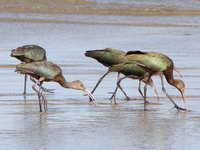
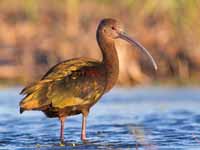
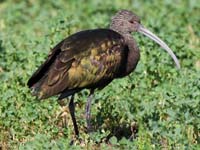
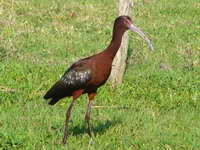
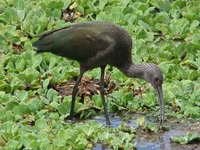


Genus Pseudibis
Ibis,_Giant Pseudibis gigantea Spmetimes placed in its on genus Thaumatibis gigantea
Description: Largest ibis. Greyish-brown plumage; naked greyish head; yellowish-brown bill; orange legs; dark red eyes. Length 100 cm (39 in), height 100 cm (39 in), weight 4.2 kg (9.3 lb).
Range: Southeast Asia.
Habitat and Behavior: Prefers lowlands such as: marshes, swamps, lakes, wide rivers, flooded plains.
Status: Critically Endangered.
Image by: 1) Chaiyan_Kasorndorkbua 2) James_EatonRange: Southeast Asia.
Habitat and Behavior: Prefers lowlands such as: marshes, swamps, lakes, wide rivers, flooded plains.
Status: Critically Endangered.
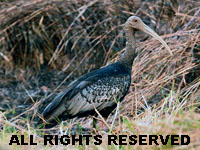
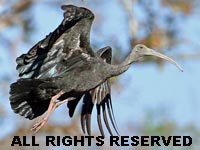
Ibis,_White-shouldered Pseudibis davisoni Found: SW China to Myanmar, peninsular Thailand and Indochina
Description: Mainly brownish-black plumage; bare slate-black head; white patch upper neck; glossy blue-black wings, tail; dull red legs. Eats mainly worms, mole, crickets, leeches, insects, beetle larvae.
Range: Southeast Asia.
Habitat and Behavior: Mainly appears in dry forests. Not observed foraging in water.
Status: Critically Endangered.
Image by: 1) David_Cook - Cambocia Range: Southeast Asia.
Habitat and Behavior: Mainly appears in dry forests. Not observed foraging in water.
Status: Critically Endangered.
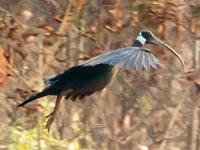
Genus Pseudibis
Southeast Asian Ibis
Ibis,_Red-naped also Black Ibis Pseudibis papillosa
Description: Brown body, neck; glossy black with blue-green wings, tail; black head with crimson patch; white patch near shoulder; grey legs, and bill turn red during breeding season.
Range: Indian Subcontinent.
Habitat and Behavior: Prefers lakes, marshes, riverbeds, irrigated farmlands. Eats carrion, insects, frogs, even grain. Nest high in trees; not colonially. Nest made with sticks and lined with straw. Pale bliush-green eggs.
Status: Least concern.
Image by: 1) J M Garg in Haryana, India 2) Joby Joseph - India 3) Niraj Mistry 4) Jan Arendtsz 5) Charlene Wood Range: Indian Subcontinent.
Habitat and Behavior: Prefers lakes, marshes, riverbeds, irrigated farmlands. Eats carrion, insects, frogs, even grain. Nest high in trees; not colonially. Nest made with sticks and lined with straw. Pale bliush-green eggs.
Status: Least concern.
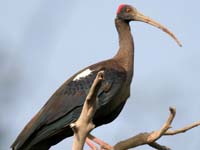

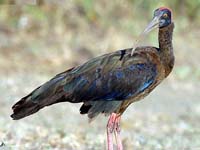
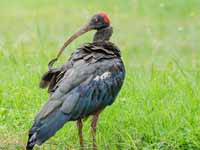
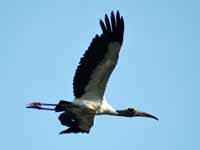
Genus Theristicus
Found in open, grassy habitats in South America. All have a long, decurved dark bill, relatively short reddish legs that do no extend beyond the tail in flight, at least the back is gray.
Ibis,_Black-faced Theristicus melanopis Found southern South America
Description: Grey upperparts; black flight feathers; buffish head, neck, lower-breast; grey breast band; cinnamon crown, nape; blackish bill, wattle, bare skin around eyes.
Range: southern South America.
Habitat and Behavior: Wetlands, fields. Not colonial nester.
Subspecies:
T. m. branickii – Andes of Ecuador to extreme n Chile. Also considered species Andean ibis
T. m. melanopis -Coastal Peru, n Chile and Argentina south to Tierra del Fuego
Status: Least concern.
Similar to: Buff-necked Ibis. Buff-necked Ibis has large white wing-patches; Black-faced Ibis does not.i
Image by: 1) dFaulder at Puerto Montt, Chile 2, 3, 5) Cláudio
Timm Calafate, Argentina 4) Dick Daniels - Andes of Peru Range: southern South America.
Habitat and Behavior: Wetlands, fields. Not colonial nester.
Subspecies:
T. m. branickii – Andes of Ecuador to extreme n Chile. Also considered species Andean ibis
T. m. melanopis -Coastal Peru, n Chile and Argentina south to Tierra del Fuego
Status: Least concern.
Similar to: Buff-necked Ibis. Buff-necked Ibis has large white wing-patches; Black-faced Ibis does not.i
1) Juvenile 2, 3, 4) Nonbreeding 5) Breeding 4) Andean subspecies also known as Andean Ibis
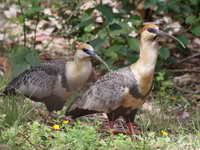
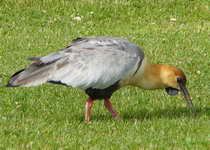
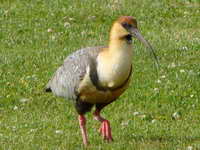

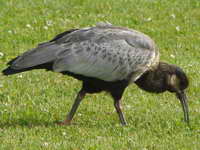
Ibis,_Buff-necked also White-throated Ibis Theristicus caudatus
Description: Grey upperparts; black belly, flight feathers; large white wing patch visible in flight; buffish head, neck, lower-breast; cinnamon crown, nape; blackish bill; blackish bare skin around eyes; red legs.
Range: northern and central South America.
Habitat and Behavior: Prefers fields, marshes, savanna, grasslands. Eats mainly invertebrates; also small mammals.
Subspecies:
T. c. caudatus – Colombia to Venezuela, Guianas and sw Brazil (Mato Grosso)
T. c. hyperorius – Bolivia to se Brazil, Paraguay, Uruguay Argentina
Status: Least concern.
Similar to: Black-faced Ibis. Buff-necked Ibis has large white wing-patches; Black-faced Ibis does not.i
Image by: 1, 2) Claudio Timm - Brazil 3) Dario Sanches 4) Fabio Meffei Range: northern and central South America.
Habitat and Behavior: Prefers fields, marshes, savanna, grasslands. Eats mainly invertebrates; also small mammals.
Subspecies:
T. c. caudatus – Colombia to Venezuela, Guianas and sw Brazil (Mato Grosso)
T. c. hyperorius – Bolivia to se Brazil, Paraguay, Uruguay Argentina
Status: Least concern.
Similar to: Black-faced Ibis. Buff-necked Ibis has large white wing-patches; Black-faced Ibis does not.i
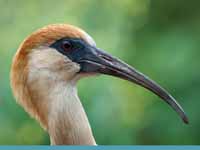
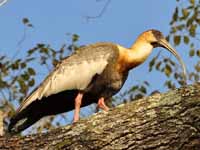
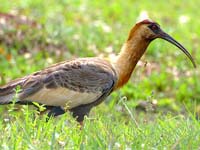
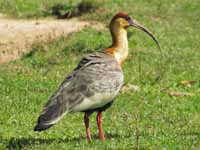
Ibis,_Plumbeous Theristicus caerulescens
Description: Mainly grey plumage; elongated plumes on neck; white forehead; reddish legs. Length 71–77 cm.
Range: central South America.
Habitat and Behavior: Found in wetlands, particularly the Pantanal (flooded grasslands mainly in Brazil). Eats aquatic invertebrates, fish, frogs.
Status: Least concern.
Image by: 1) Dario Niz - Uruguay 2, 3)
Cláudio
Timm in Rio Grande do Sul, Brazil 4) Bernard_Dupont - BrazilRange: central South America.
Habitat and Behavior: Found in wetlands, particularly the Pantanal (flooded grasslands mainly in Brazil). Eats aquatic invertebrates, fish, frogs.
Status: Least concern.
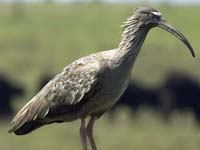
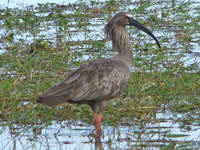

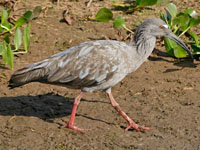
Genus Threskiornis
They occur in the warmer parts of the Old World in southern Asia, Australasia and sub-Saharan Africa.
Ibis,_Australian White Threskiornis molucca Found: Australia
Description: Mainly white plumage; black head, bill, tail, legs. Length 65–75 cm (26–30 in), weight 1.4–2.5 kg (3.1–5.5 lb).
Range: Australia.
Habitat and Behavior: Occurs marshy wetlands, open grasslands, city parks, rubbish dumps. Eats invertebrates, human scraps, crayfish, mussels.
Subspecies:
T. m. molucca – Australia to s New Guinea, Moluccas , Lesser Sundas
T. m. pygmaeus – Solomon Islands (Rennell and Bellona)
Status: Least concern.
Similar to: Black-headed Ibis, White Ibis. Range does not overlap.
Image by: 1, 2, 3) Dick Daniels - Australia Range: Australia.
Habitat and Behavior: Occurs marshy wetlands, open grasslands, city parks, rubbish dumps. Eats invertebrates, human scraps, crayfish, mussels.
Subspecies:
T. m. molucca – Australia to s New Guinea, Moluccas , Lesser Sundas
T. m. pygmaeus – Solomon Islands (Rennell and Bellona)
Status: Least concern.
Similar to: Black-headed Ibis, White Ibis. Range does not overlap.

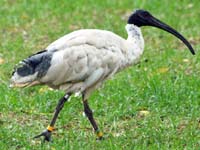
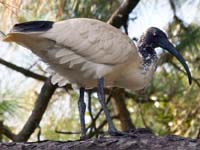
Ibis,_Black-headed Threskiornis melanocephalus Found: south Asia, India, Japan
Description: Mainly white plumage; black head, neck, bill, tail, legs. Breeding: red bare patches under wing. Juvenile: greyish feathering on the neck.
Range: south Asia, India, Japan.
Habitat: Utilize freshwater and salt-water marshes, lakes, ponds, rice fields, freshly plowed crop fields, irrigation canals, riversides.
Status: Near threatened.
Similar to: Australian White Ibis, White Ibis. Range does not overlap.
Image by: 1) Allan Hopkins 2, 5) Vijay Ismavel 3) Ravi Vaidyanathan 4) J M Garg Range: south Asia, India, Japan.
Habitat: Utilize freshwater and salt-water marshes, lakes, ponds, rice fields, freshly plowed crop fields, irrigation canals, riversides.
Status: Near threatened.
Similar to: Australian White Ibis, White Ibis. Range does not overlap.
1) Juvenile

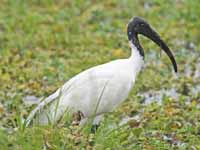
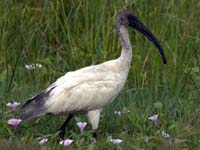
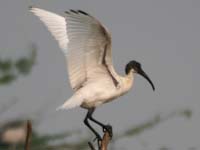
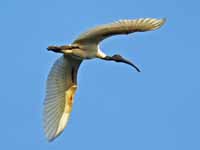
Ibis,_Sacred Threskiornis aethiopicus Also known as African Sacred Ibis
Description: Mainly white plumage; black head, bill, wingtips, tail, legs; brown eyes with dark red orbital ring. Length 68 cm (27 in), wingspan 112 to 124 cm (44 to 49 in), weight 1.35 to 1.5 kg (3.0 to 3.3 lb).
Range: Sub-Saharan Africa.
Habitat and Behavior: Prefers marshy wetlands, mud flats including coastal areas. Mainly nests on trees near water. Eats mainly crustaceans, fish.
Status: Least concern.
Image by: 1) Dick Daniels - Flamingos Wildlife Reserve in Las Vegas. 2) Dick - World of Birds, South Africa 3) Charlie Westerinen - the Okavango Delta in Botswana 4, 5) Dick - Fish Eagle Lodge, Knysna Lagoon, KenyaRange: Sub-Saharan Africa.
Habitat and Behavior: Prefers marshy wetlands, mud flats including coastal areas. Mainly nests on trees near water. Eats mainly crustaceans, fish.
Status: Least concern.
6) Joseph Mochoge - Gilgil, Kenya 7) Cristiano Crolle - near Novara, Italy
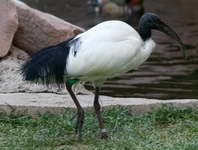

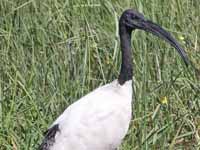


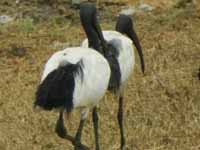

Ibis,_Straw-necked Threskiornis spinicollis Found: Australia, New Guinea
Description: Black back, collar; glossy black wings may have colored sheen; mostly white neck; white belly, under-tail. Length 59–76 cm (23–30 in), wingspan 100–120 cm (39.5–47 in), weight 1.1–1.5 kg (2.5–3.5 lb).
Range: Australia, New Guinea, parts of Indonesia.
Habitat and Behavior: Favor shallow freshwater wetlands, cultivated pastures, edges of swamps and lagoons, wet or dry grasslands. Typically fly in line or in V formation, at high altitudes during long travel. Eat mainly aquatic and terrestrial invertebrates; also insects, frogs. Colonial nest in trees or bushes.
Status: Least concern.
Image by: 1) Cyron Ray Macey 2) Dick Daniels - Australia
3) JJ Harrison - Australia 4) Laurie_Boyle 5) Charlie Westerinen - Goulburn AustraliaRange: Australia, New Guinea, parts of Indonesia.
Habitat and Behavior: Favor shallow freshwater wetlands, cultivated pastures, edges of swamps and lagoons, wet or dry grasslands. Typically fly in line or in V formation, at high altitudes during long travel. Eat mainly aquatic and terrestrial invertebrates; also insects, frogs. Colonial nest in trees or bushes.
Status: Least concern.
